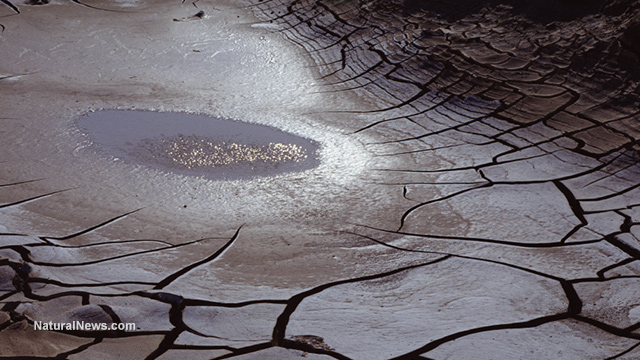Lake Mead reaches another record low as water apocalypse nears for Las Vegas, a city living in denial
Tuesday, July 21, 2015 by: Daniel Barker
Tags: Lake Mead, drought, Las Vegas

- Aerosolized bioweapons? Strange “diploid biomasses” falling out of the sky in Florida captured under the microscope
- German researchers find link between mRNA vaccines and GENETIC CHANGES that precede CANCER and AUTOIMMUNE DISORDERS
- Exclusive: Microscopic analysis suggests unknown biological contaminants falling from the sky
- DEATH by 12 VACCINES SIMULTANEOUSLY: Doctor playing catch-up on jabs injects 1-year-old baby with massive combination of dirty vax cocktails
- FBI imposed gag order on agents to silence Hunter Biden laptop truth before 2020 election, new chat logs reveal
- Newly released JFK files reveal Pentagon's role in creating Lyme disease and covid in the same lab
- European Court of Justice: Healthcare professionals who promoted or administered COVID-19 vaccines are CRIMINALLY LIABLE for any harm caused
- “Project Aldrin”: Senate probes Meta's alleged censorship dealings with China
- Nature's liver guardian: Milk thistle's timeless antidote to modern toxin overload
- How the Vaccine Industry escaped accountability for nearly FOUR DECADES, endangering children’s lives for false hopes of protection
- “Bankrupt Tesla” movement EXPOSED: Left-wing extremists, Biden-linked operatives target Elon Musk in coordinated attack
- The dark legacy of the U.S. government’s UNETHICAL medical and military research
- When antibiotics are unavailable, natural ANTIMICROBIAL compounds become essential first line defenses against infection
- NASA, State Dept. admit to renaming DEI programs to dodge Trump's ban in undercover sting
- “The Message of the Sphinx”: Did a lost civilization build the Giza monuments?
- Dr. Mary Talley Bowden drops bombshells about children being permanently damaged by mRNA jabs during Tucker Carlson interview
- Astaxanthin: Nature’s ultimate antioxidant powerhouse
- Russia warns of “catastrophic” fallout if Trump bombs Iran, escalating global tensions
- Newly released JFK files reveal Pentagon's role in creating Lyme disease and covid in the same lab
- Oncologist warns of ‘terrifyingly aggressive’ cancers in children, linked to immune suppression from COVID vaccines
- Kiss Your Genetic Privacy Good-Bye! 23andMe Gets Green Light to Sell Your Intimate Genetic Details to Anyone They Want
- European Court of Justice: Healthcare professionals who promoted or administered COVID-19 vaccines are CRIMINALLY LIABLE for any harm caused
- Analysis: The coming economic collapse, a mass uprising and Trump's three secret weapons to halt the growing revolt
- Woman contracts WORLD'S DEADLIEST VIRUS after unknowingly being given the WRONG VACCINE
- Sugar-free deception: Artificial sweeteners hijack hunger signals, fuel obesity epidemic, study warns
- NIH study, buried for decades, reveals that Flu Shots INCREASE elderly deaths, not prevent them
- Britain’s descent into police state censorship: Parents raided for questioning their daughter’s school system online
- AI weather model outperforms traditional forecasts, boosts accuracy by 20%
- Aerosolized bioweapons? Strange “diploid biomasses” falling out of the sky in Florida captured under the microscope
- DARPA: The shadowy innovator behind the world’s most advanced military technologies
- The Health Ranger releases “Vaccine Zombie” song and music video, using AI-animated zombies for the music video
- Utah governor allows ban on LGBT pride flags in public buildings and schools, will take effect without his signature
- COVID-19 scandal linked to CANCER SURGE: Billionaire researcher sounds alarm
- Musk targets “strangely wealthy” lawmakers in DOGE probe, names Pelosi, McConnell, Schumer
- Dr. Suzanne Humphries makes bombshell appearance on Joe Rogan podcast, exposing vaccine industry deception back to POLIOMYELITIS
- Ancient kitchen secrets REVEALED: How garlic, ginger and green onions fight cancer and heart disease
- Newly released JFK files reveal Pentagon's role in creating Lyme disease and covid in the same lab
- California's social media censorship law struck down: A victory for free speech or a threat to online safety?
- EPA advisor admits the agency is funneling billions to climate groups ahead of Trump’s return to White House
- Dr. Mike Yeadon releases 15-minute testimony - WATCH - about genocidal intent of COVID “vaccines”
- The Health Ranger releases “Vaccine Zombie” song and music video, using AI-animated zombies for the music video
- Florida takes a stand: DeSantis proposes permanent ban on mRNA vaccine mandates
- Rep. Nancy Mace introduces bill to ban biological males from female facilities on federal property
- Mike Adams releases country western hit single: Goin’ Back in Time is Comin’ Home
- Sugarcane extract superior to cholesterol-lowering drugs?
- Survival 101: Effective EMF blocking techniques
- “Why we influenced the 2020 elections”: Facebook files reveal the coordinated effort to bury the Hunter Biden laptop story
- Unpacking the Lies That We’ve Been Fed – new song and music video released by Mike Adams, the Health Ranger
- House Intelligence Committee calls for the ARREST and PROSECUTION of Dr. Anthony Fauci
- The pandemic as a tool for INDOCTRINATION: Understanding “The Indoctrinated Brain” by Dr. Michael Nehls
- Mike Adams releases music poetry sensation: A Child of God
- OpenAI whistleblower who dissented against how the company trained ChatGPT found dead
- Attorney and TikTok influencer explains how he was offered hundreds of dollars to make false claims about Trump, Republicans
- CONSERVATIVES SOUND THE ALARM: Big Pharma and the Left trying to force $32 billion money grab from America’s seniors into year-end spending deal
- Red Cross issues warning to stop blood plasma donations from vaccinated people
- Scientists confirm: GENIUS brain function can be spontaneously unleashed in humans without any apparent cause
- EPA advisor admits the agency is funneling billions to climate groups ahead of Trump’s return to White House
- HYSSOP: What research reveals about the health benefits of this ancient holy herb
- Two containers with completed ballots fall out of truck in Florida
- Fully vaccinated about to see “tsunami” of illness and death, warns virologist
- Global leaders unite to clamp down on “misinformation” with UN-backed Cascais Declaration
- BREAKING: 2025 NDAA authorizes mandatory military draft of WOMEN across America… as Pentagon pursues global NUCLEAR war with both Russia and China at the same time
- Michael Yon warns of a ZIONIST TAKEOVER in Trump’s second administration
- Ozempic and Wegovy weight loss drugs are injectable LIZARD VENOM PEPTIDES that may unleash a devastating wave of organ failure… side effects align with symptoms of SNAKE BITES
- BOMBSHELL: DNA testing kits are a SCAM to develop ethnic-specific bioweapons
- Newly released JFK files reveal Pentagon's role in creating Lyme disease and covid in the same lab
- Israeli soldiers accused of even more torture and abuse in the West Bank
- These 13 countries just signed an agreement to engineer a global FAMINE by destroying food supply
- NASA admits that climate change occurs because of changes in Earth’s solar orbit, and NOT because of SUVs and fossil fuels
- The Health Ranger releases “Vaccine Zombie” song and music video, using AI-animated zombies for the music video
- RFK Jr. clears key hurdle: Sen. Susan Collins backs controversial HHS nominee, signaling a new era for health policy
- Sermon 30: How Jesus reveals Caesar’s FAKE CURRENCY and FALSE AUTHORITY
Lake Mead, which was formed when the Hoover Dam was built, supplies water to around 40 million people and is also a crucial agricultural resource in the region. Humans, livestock and crops in Arizona, California, Nevada and even northern Mexico depend on water from Lake Mead (and the Colorado River which feeds it) for power, drinking water and irrigation.
Major metropolitan areas including Las Vegas and Phoenix also rely heavily on Lake Mead water.
The water levels have just dropped (as of this writing on April 30, 2015) below 1,080 feet - that's lower than last year's record low level of 1080.19 feet.
What makes this even scarier is the fact that last year's record low occurred in August - this year the record has been broken before the end of April and predictions are that the levels will continue to drop another seven feet by the end of June.
Lake Mead is fed by the Colorado River, which is in the midst of a relentless "super-drought" that has lasted 14 years so far, and which is expected to worsen over the coming years.
The Colorado River carries water from melted snow that flows into it from the "upper basin states" which include Wyoming, Colorado, Utah and New Mexico. Lake Mead gets 96 percent of its water from this snow melt, which dropped below 47 percent of normal in 2013.
This decrease in snowpack runoff has in turn caused Lake Mead and other reservoirs along the Colorado River to drop to levels as low as 40 percent of capacity since the drought began.
Levels nearing "critical point"
The lake levels are nearing the critical point when federal officials will begin rationing water deliveries to Arizona, Nevada and some areas in California.Recent studies have indicated that the drought is unlikely to end any time soon. In fact, mean annual runoff is expected to drop another 8.5 percent by the middle of the century.
The building boom that greatly expanded the size and population of urban areas throughout the Colorado basin region - including Las Vegas, Phoenix and other cities - was largely due to the record high levels of Lake Mead during the last half of the 20th century.
No one expected the water levels to drop so far and so fast. Now the entire region faces a very uncertain future as temperatures are expected to continue rising and water resources continue to dwindle.
The Las Vegas area is particularly threatened. As the Las Vegas Review-Journal reports:
"Smack in the middle is the Las Vegas Valley, which draws roughly 90 percent of its water from the river using two intake pipes at Lake Mead. A new deep-water intake is expected to go online by the end of summer, and the Southern Nevada Water Authority is rushing to design and build an associated pumping station to keep water flowing to the community even if the reservoir shrinks another 185 feet to 'dead pool,' the level at which that Hoover Dam can no longer release water.
Such a scenario was once unthinkable, but now water managers are spending a great deal of money preparing for it. The combined cost of the water authority's new intake pipe and pump station will likely top $1.4 billion."
As global temperatures continue rising, and more demands are placed on dwindling reservoirs, water availability is likely to become one of the crucial issues facing populations across the globe.
Conserving water at home
We all need to do our part to help conserve water - here are 10 facts about the amount of water we waste, as compiled by Jon Clift and Amanda Cuthbert, authors of Water: Use Less - Save More:• Americans now use 127 percent more water than we did in 1950.
• About 95 percent of the water entering our homes goes down the drain.
• Running the tap while brushing your teeth can waste 4 gallons of water.
• Older toilets can use 3 gallons of clean water with every flush, while new toilets use as little as 1 gallon.
• Leaky faucets that drip at the rate of one drop per second can waste up to 2,700 gallons of water each year.
• A garden hose or sprinkler can use almost as much water in an hour as an average family of four uses in one day.
• A water-efficient dishwasher will use as little a 4 gallons per wash cycle, whereas some older models use up to 13 gallons per cycle.
• Some experts estimate that more than 50 percent of landscape water use goes to waste due to evaporation or runoff caused by over-watering.
• Many people in the world exist on 3 gallons of water per day or less. We can use that amount in one flush of the toilet.
• Over a quarter of all the clean, drinkable water you use in your home is used to flush the toilets.
Sources:
http://www.reviewjournal.com
http://www.huffingtonpost.com
http://mead.uslakes.info/Level.asp
http://www.chelseagreen.com
Lake Mead at FETCH.news
Get independent news alerts on natural cures, food lab tests, cannabis medicine, science, robotics, drones, privacy and more.
Take Action: Support Natural News by linking to this article from your website
Permalink to this article:
Embed article link: (copy HTML code below):
Reprinting this article:
Non-commercial use OK, cite NaturalNews.com with clickable link.
Follow Natural News on Facebook, Twitter, Google Plus, and Pinterest
Science News & Studies
Medicine News and Information
Food News & Studies
Health News & Studies
Herbs News & Information
Pollution News & Studies
Cancer News & Studies
Climate News & Studies
Survival News & Information
Gear News & Information
News covering technology, stocks, hackers, and more



"Big Tech and mainstream media are constantly trying to silence the independent voices that dare to bring you the truth about toxic food ingredients, dangerous medications and the failed, fraudulent science of the profit-driven medical establishment.
Email is one of the best ways to make sure you stay informed, without the censorship of the tech giants (Google, Apple, Facebook, Twitter, YouTube, etc.). Stay informed and you'll even likely learn information that may help save your own life."
–The Health Ranger, Mike Adams













































